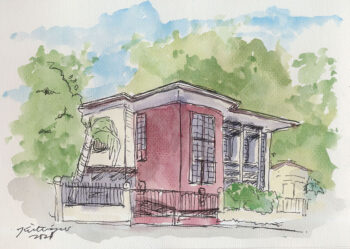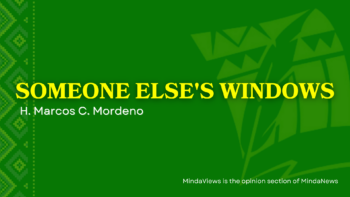
MALITA, Davao del Sur (MindaNews / 06 November) — If you google “Tagakolu,” your search results would probably yield various spellings of the name. The most common question people ask is: “So, which one is the correct spelling?” To help find an answer, I started looking into published documents from the past to the present to see what I could find. I would like to share what I have discovered that helped me understand why there are several ways of writing the name of the Tagakolu people.
To start with, it was foreigners who first wrote down the name of the people when they first met them. The Spanish Jesuits wrote about them in the late 19th century and they wrote the name of the people as Tagacaolo. Fr. Quirico More mentioned them in his letter written in 1885 (Blair and Robertson 1903-1909, 43:199). After him Fr. Mateo Gisbert also wrote about them in 1886 (Ibid: 240) and Fr. Pablo Pastells in 1887 (Ibid: 279-80). All of them wrote Tagacaolo. When the Spanish Jesuits encountered the Tagakolu, they wrote the name that they heard and wrote it down using the Roman alphabet, which is the same alphabet we use today. But they wrote the name according to how they write in Spanish. For example, the Spanish language uses the letter “c” where we Filipinos would otherwise use “k”. The Spanish for chain is cadena, which we have appropriated and write as kadena. For the rest of the letters in the name, I can only speculate why they wrote it this way. What is clear is, at least based on historical documents, the Spanish wrote the name of the people as Tagacaolo.
In early 20th century, another foreigner wrote down the name of the people based on the Spanish spelling. The American anthropologist Fay-Cooper Cole published his research on the peoples of Mindanao and spelled the name of the people as Tagakaolo. His research was entitled “The Wild Tribes of Davao” (Fay-Cooper Cole 1913), a rather offensive description, I think, from a man whose nation forcibly occupied an independent nation. But that is another story. Going back to the name, Cole’s spelling only slightly differs from that of the Spanish spelling where he replaces the “c” with a “k.” Henceforth, various publications of both government institutions, non-government organizations and private individuals would write the name of the Tagakolu people as either Tagacaolo or Tagakaolo.
In the late 20th century, Catholic missionaries from Canada introduced another spelling of the people’s name. Their literacy program at the Sto. Rosario Parish of Malita in Davao del Sur published the workbook “Magbasa Kita” (Sto.
Rosario Parish 1988). In the workbook for Tagakolu children, they wrote the name as Tagakaulo. This spelling of the name revises the American spelling by replacing the “o” in “kao” with a “u” thus making it “kau” instead. Thus, the name is now spelled as Tagakaulo.
Ten years later, the Summer Institute of Linguistics (SIL) composed of Christian missionaries from the United States and the Philippines published a language learning book entitled “Magbalawbalaw Kitadun: A Tagakaulo, Visayan, Filipino, English Phrasebook” (Burton and Mata 1998) using the same spelling. This manner of writing the name of the indigenous community would later be widely used among Churches and non-government institutions directly or indirectly working with the various Tagakolu communities in the provinces of Sarangani and Davao del Sur. Government agencies in and around these areas would also use this spelling.
Worth noting as well are two spellings of the name that did not gain popular use in subsequent publications like the others mentioned above. One I encountered in the text of the “Tagakaulu Kalagan Dictionary” (Murray 1983). They used kau in the orthography that their colleagues at SIL would later use. The last syllable lo, however, becomes lu for the Murrays. For one reason or another, the dictionary was never completed and the dictionary never reached publication. Another is from Emmanuel S. Nabayra, a professor at the University of the Philippines in Mindanao. In an unpublished article entitled “The Mandaya-Mansaka-Kalagan Continuum”, he writes Tagakolu as Tagakawlo. The third syllable of the name is written as kaw.
In the early 21st century, a member of the Tagakolu people proposed another way of writing the name. Marites Gonzalo, a Tagakolu anthropologist from Pinalpalan, Malita, Davao Occidental, wrote in her thesis that the more appropriate spelling of her people’s name is Tagakolu (Gonzalo 2017). In her thesis entitled “Ang ‘Kolu’ ug ang Pakigbisog sa Pagpatunhay sa ‘Pagka-Tagakolu’” she expounds that her people have lived in the kolu for many generations even before the arrival of the Spanish Jesuits. The kolu, she says, refers to the forests in the mountains where the water sources are. The Tagakolu share the kolu with the different trees, plants and animals that abound together with the spirits that dwell in and who look after the kolu. The kolu also provides food and medicine for the Tagakolu. Ask any Tagakolu and they will tell you that the higher region of the mountain is called kolu. This is why they are Tagakolu, the people who live in the kolu. Here at the Malita Tagakaulo Mission (MATAMIS), we use two spellings: Tagakaulo and Tagakolu. We have retained the spelling Tagakaulo in the name of the mission station for practical purposes: this is the name that we use in our legal and ecclesiastical documents. However, for everything else we write the name as Tagakolu.
So, which one is the correct spelling of the name? Honestly, I am not in the position to say which one. Here is what I think, though. If and when the time comes for an official spelling to be decided upon, it would be high time to let the bearers of the name, the people of the land, decide what it should be.
(MindaViews is the opinion section of MindaNews. Fr. Joey Gánio Evangelista, MJ, heads the Malita Tagakaulo Mission of the Diocese of Digos. The mission is based in Malita, Davao Occidental)
References used:
Blair, Emma Helen and James Alexander Robertson, eds. The Philippine Islands, 1493-1898. 55 vols. Cleveland, Ohio: Arthur H. Clark, Co., 1903-1909.
Burton, Scott L. and Becky A., and Mila S. Mata. Magbalawbalaw Kitadun: A Tagakaulo, Visayan, Filipino, English Phrasebook. Manila: Summer Institute of Linguistics, 1998.
Cole¸ Fay-Cooper. Wild Tribes of Davao. Chicago: Field Museum of Natural History, 1913.
Gonzalo, Marites T. Ang ‘Kolu’ ug ang Pakigbisog sa Pagpatunhay sa ‘Pagka-Tagakolu.’ Ateneo de Davao University, 2017.
Magbasa Kita, Malita, Davao del Sur: Tagakaulo Literacy Program, Sto Rosario Parish, 1988.
Murray, Don and Mary. Tagakaulu-Kalagan Dictionary. Unpublished, 1983.
Nabayra, Emmanuel E. The Mandaya-Mansaka-Kalagan Continuum. Unpublished.







